 |
The Rhone Glacier

Those who are spending their holidays at the Swiss mountains, will find a huge abundance of glaciers. As steep precipices and cliffy rocks, the glaciers also belong to the high mountains. Only in the area of Zermatt, two hands are needed to count each of the glacier tongues. The Aletsch Glacier is the biggest and most famous glacier of the Alps. But one glacier is at least as spectacular, although it is a mite compared to the big Aletsch Glacier: the Rhone-Glacier.
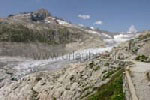
Those who come from the Furka-Pass will unevitably pass the Rhone glacier. Also those who do not know that a few kilometres after the summit, a spectacular glacier will follow, have to stop automatically, as the Rhone-Glacier nearly forces itself to one. A big, cost free parking place at the bottom of the legendary Hotel Belvédère is located right at the mountain pass and invited to have a stopover. If wanted, one can also stay over night here; but this is only worthwhile for photography-freaks, who unconditionally want to picture the Rhone Glacier at the sunset light or during the sunrise.
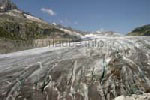
What makes the Rhone Glacier to be so exciting as no other else? Oneself is at a height of 2272 m. At the left and at the right of the polar sea, the three-tousander summits Furkahorn (3169 m) and Gerstenhorn (3189 m) string together. In-between, the glacier flows down the valley. As known, a glacier flows smoothly alongside the valley surface and breaks into big ice chunks, when the valley underneath falls cliff-like into the deepness. As a visitor, one stands right in this spot by walking on the observation surface at the Rhone-Glacier.
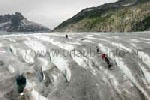
This costs 3,50 € entrance fee. Even if one only walks a few hundred metres, it is recommendable to take off the sandals and put on some solid foot-wear, as the path is a little precipitous and one can easily slip on the ice. On a well secured path, one walks up to the lower edge of the glacier tongue. What looks as an ice surface with some little scratches on the picture, is actually a big polar sea with more than 10 m deep crevasses. The picture with the climbers clarify the proportions.
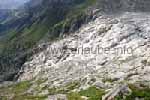
Each day, the Rhone Glacier flows approximately 10-15 cm downstream. At the glacier snout, the water falls downwelling down the Rhone Valley. Thus, here, the little river Rhône, which name is still Rotten in the beginning, is originated. It is hard to believe that this little river ends in the Mediterranean sea as a wide river in a huge delta near Marseille. What is also hard to believe is that 20 years ago, the glacier extended umpteen metres deep into the valley but lost a lot of substance in the last two warm decades. It is almost unbelievable that 200 years ago, thus at the beginning of the 19th century, the Rhone Glacier ran down into the little place Gletsch that was located approximately 500 m deeper . But this given fact can also be beaten: 350.000 years ago during the Riss-Glacial-Period, the whole Alp Glaciers ran up to Lyon in the core of France; only the Four-thousander summits raised from the polar sea.
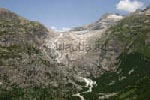
But at the Rhone Glacier, there is more to see than ice and rocks: each year, a tunnel of approximately 100 m is drilled into the glacial ice that disembogues in an ice grotto. By getting into this ice grotto, one practically gets amidst the glacier. It is self evident that, amidst a glacier, the temperatures are around the freezing point, thus, that one should not get into a glacial ice grotto in shorts and a t-shirt.
By the way, the ice grotto moves in accordance to the glacier, thus approximately 10 cm per day downstream. Due to this reason, each year, it has to be rearranged. It is also easy to calculate that from the approximately 100 m long ice tunnel, at the end of the summer, only approximately 70 m are remaining. It is a queasy feeling to be inside of a glacier grotto and to know that everything around one is moving downstream in a snail's pace.
More information of the glaciers
When a high mountain region is covered with ice, either in the summer as also in the winter time, it is generally talked about the perpetual ice. A glacier that begins at the very top of the mountain and which tongue ends somewhere further down in the valley, at first sight, it appears to be statical as a lake or a mountain. In reality, the whole glacier is constantly moving; principally, it is as a big river in which no water but ice is flowing.
A glacier can be divided in two major areas, in its head area and its bottom area. In the head area above, snow falls and permanently feeds the glacier with new material. In the bottom area, the ice melts and flows into the glacier brook downwards the valley. The part of the glacier of which the glacial milk leaks out is also called Glacier Snout. The glacial water is not clear but milky due to the reason that finest rubble masses that were carried by the ice during its flow, resoluted in this water.
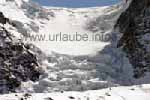
A typical glacier of the Alps as the Rhone Glacier or the big Aletsch Glacier flows with a speed of approximately 10-15 cm per day downstream. Of course, this flowing cannot be viewed with the naked eye, but one hears the ice cracking and breaking, one hears the water flowing and sometimes one can see an ice chunk falling into the valley.
How is glacial ice generated at the head area of the glacier? First, there is simple snowfall that due the change of day to night temperature it is converted to névé. Under the pressure of the own weight, it is converted to Firn Ice, which crystals grow increasingly due to the fluctuation of temperature in the day and the night and let the encased oxygen leak out, until finally, the blue-green glacial ice is generated.
The ice that is formed in the upper glacial area flows very slowly downstream, right alongside the profile of the bottom of the valley. If the bottom of the valley is smooth and even, the glacier also forms a smooth ice cover on its surface, almost as if on a lake. But if the bottom of the valley has canyons, rock spurs or gorge portions, the ice flow has to adapt and breaks. Crevasses are generated. What is specially impressive are the horizontal cracks caused by the glacial breakups that happen when all of a sudden, the bottom the valley fall cliff-like downwards. It is obvious that the faster the glacier flows downstream, the more steeply the bottom runs. The vertical cracks are almost generated at the glacial tongue and the edge cracks are formed at the side edges of a glacier.
In the course of the milleniums, a glacier grinds a deformed valley until its smooth and pliant. From the rock material that breakes at the glacier edges and falls onto the glacial ice, a border moraineis formed; unhurriedly, the glacier transports the rock material downstream. If two glaciers with border moraines unite with each other, a Medial Moraine that glides downstream amidst the glacier (very clear to see at the big Aletsch Glacier). The rock material that was grinded in the glacier plateau is dragged in dounstream as Ground Moraine.
In the area of Zermatt, impressive glacier moraines and grinded bottoms of the valleys and valleysides are visible as a result of the reformed glaciers. It is known that, due to the present warm time, the Alp glaciers withdraw umpteen metres every year. The glaciers that widely extended down into a valley, are partly only little ice tongues at the summits; glacier that once got united became completly separated glaciers. And some glaciers have already disappeared completely.

Back to the index Zermatt
Copyright: Patrick Wagner, www.tourist-guide.biz
|
 |